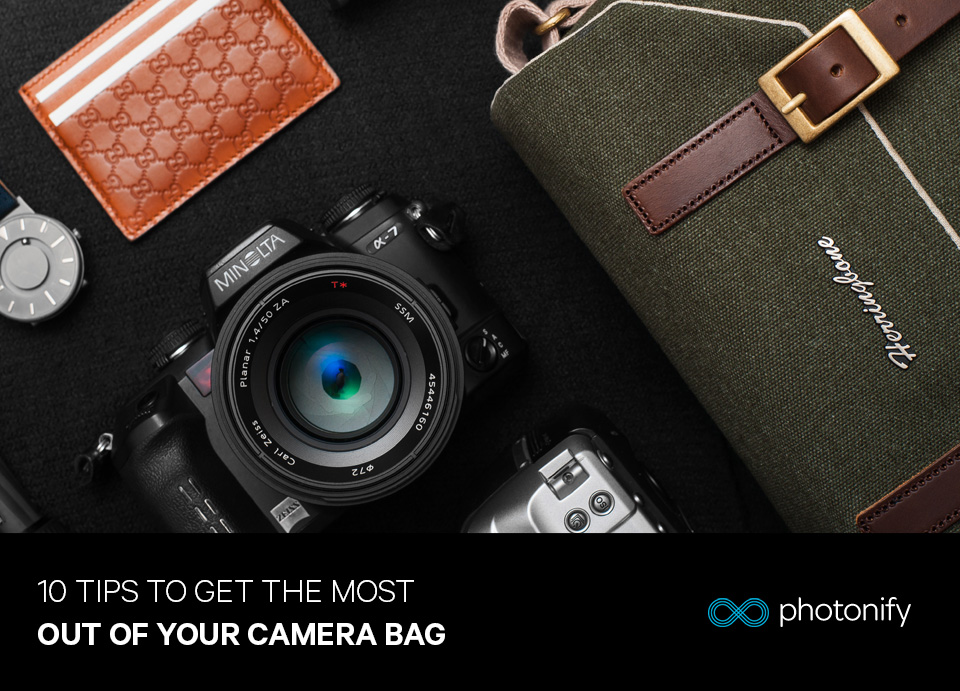
Photographic equipment bags come in a range of materials, styles and sizes. It’s a balance between having space for everything you need and being able to move around comfortably and access items as you need them. Hard cases offer better protection for valuable items, but they aren’t practical if you need to carry them far.
A camera bag allows you to carry a range of useful equipment and accessories. As well as items for cleaning and maintaining cameras and lenses, a camera bag can hold the essential tools a photographer needs every day. The items you pack will vary depending on the subjects you shoot and the way you work, but there are some items every photographer should consider packing. The following are some of the most popular and useful.
1) Lenses.
A modern zoom lens is suitable for most of the subjects a photographer will shoot, but carrying additional lenses opens up other creative possibilities. The lenses you pack in your camera bag will depend on what you plan to shoot. For example, a landscape photographer should carry a wide-angle lens and a zoom with a short focal length. Sports photographers need and 80-200mm zoom or a 300mm telephoto lens to get them close to the action.
2) A mini tripod.
It’s not always practical to carry a full-sized tripod, so packing a mini one in your camera bag can be a lifesaver. As well as making it possible to shoot in low-light conditions, a mini tripod is great for low-level shots. Camera clamps and flexible Gorillapods are good alternatives to a mini tripod.
3) A lens cleaning kit.
Keeping your lenses clean and dust-free ensures they deliver the best results. Fingerprints and specks of dust can affect the sharpness of an image. An air blower is a great tool for removing dust, sand and dirt from a lens without the risk of scratching. A microfibre lens cloth can be used to wipe away grease marks, fingerprints and drops of water. Carrying a lens cleaning kit means you can fix minor problems on the go.
4) A polarizing filter.
Polarizing filters serve several purposes. They cut glare and can eliminate reflections on windows and water. For travel and landscape photography they can be used to create dramatic, deep blue skies. Some photographers have a polarizing filter permanently fitted to a lens to protect the front element. Polarizers can be quite expensive, so consider buying one to fit the largest filter ring of all your lenses and using step-down rings to work with others.
5) A waterproof camera cover.
Even if your DSLR has weather-proofing as a feature, it should be protected from the elements whenever possible. Raindrops, moisture, sand and dust can cause serious harm to the sensitive electronics inside a digital camera. Storm jacket covers allow you to shoot in all weathers without having to worry about damaging your gear. Adverse weather conditions can be great for landscape photography, and a waterproof cover for your camera means you can keep on shooting when there’s a downpour.
6) Spare memory cards.
There’s nothing worse than being out on a shoot and having to restrict the number of pictures you take due to lack of memory space. Memory cards are small and light, so always carry at least a couple of spares. Shooting high quality images means you’ll fill memory space quickly, and deleting images is something you may regret when you get home.
7) A flashgun.
Many photographers prefer to work in natural light and avoid using flash, but there’s a time and a place for it. The key to success is a using the correct settings to make light from a flash look as natural as possible. Wedding and portrait photographers often rely on the powerful burst of light a flashgun can provide when forced to work indoors or in locations with limited daylight.
8) Spare batteries.
Traditional film cameras are mechanical, but modern DSLRs can’t be operated without power from a battery. The shutter and focusing mechanisms can drain a lot of power from a camera’s battery over a few hours, so it’s always worth carrying a spare. You should also pack spare batteries for your flashgun and any other electronic equipment in your camera bag.
9) A white balance card.
The auto white balance setting on digital cameras is accurate in most lighting conditions, but there are times when a photographer needs to set white balance manually. For example, shooting outdoors on cloudy, foggy or dull days can lead to unwanted color casts. A white balance card is a great tool for ensuring colors are captured correctly.
10) A spare camera body.
If there’s room in your camera bag, there are times when it’s worth carrying a spare body. If your camera develops a fault when you’re out on an important shoot, carrying a spare will save the day. Wedding photographers and many professionals won’t consider going on an assignment without at least one spare.
In addition to photographic equipment and accessories, some photographers carry basic tools, a multi-purpose knife, sunscreen and warm gloves in their camera bag. Choosing a bag with lots of pockets gives you the flexibility to pack for all weathers and conditions.
